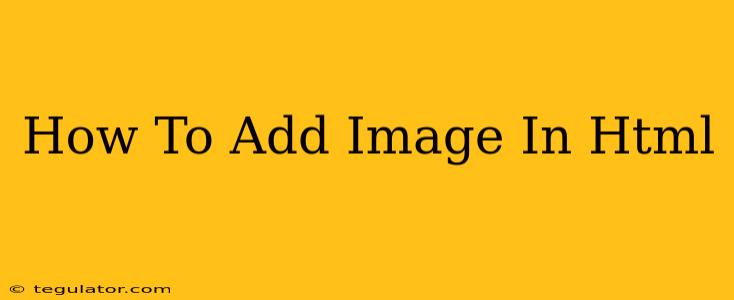Adding images to your HTML documents is a fundamental skill for any web developer. It's surprisingly straightforward, but understanding the nuances of the <img> tag and best practices will significantly improve your website's appearance and user experience. This guide will walk you through everything you need to know.
Understanding the <img> Tag
The core of adding images to your HTML lies within the <img> tag. This tag is a self-closing tag, meaning it doesn't require a separate closing tag like </img>. It uses attributes to specify the image source and other properties.
The most important attribute is src, which specifies the path to your image file. This path can be relative (relative to the location of your HTML file) or absolute (a full URL).
Example:
<img src="myimage.jpg" alt="Description of my image">
In this example:
src="myimage.jpg"tells the browser to find an image namedmyimage.jpgin the same directory as the HTML file.alt="Description of my image"provides alternative text for the image. This is crucial for accessibility (screen readers) and SEO.
Essential Attributes for Image Optimization
While the src attribute is essential, several other attributes significantly enhance the image display and website performance:
-
alt(Alternative Text): This attribute is vital for accessibility and SEO. Describe the image concisely and accurately. Screen readers use this text to convey the image content to visually impaired users. Search engines also use it to understand the image's context. -
widthandheight: Specifying the width and height (in pixels) improves page load speed. The browser doesn't need to download the image to determine its dimensions. This helps with the overall layout and user experience. -
title: This attribute provides a more detailed description than thealtattribute, displayed as a tooltip when the user hovers over the image. It is beneficial for conveying additional information. -
loading="lazy": This attribute is a performance booster, especially on pages with many images. It tells the browser to load the image only when it's about to become visible in the viewport, improving initial page load time.
Example with additional attributes:
<img src="myimage.jpg" alt="A beautiful mountain landscape" title="Majestic peaks in the Alps" width="800" height="600" loading="lazy">
Image File Formats: Choosing the Right One
The choice of image format (JPEG, PNG, GIF, WebP) significantly impacts file size and image quality.
-
JPEG (JPG): Excellent for photographs and images with many colors and smooth gradients. Offers good compression, resulting in smaller file sizes. However, it's lossy compression, meaning some image data is lost during compression.
-
PNG: Suitable for images with sharp lines, text, and logos. Provides lossless compression, preserving all image data. Generally larger file sizes than JPEGs. Supports transparency.
-
GIF: Supports animation and transparency but limited color palette. Generally used for simple animations and logos.
-
WebP: A modern format offering both lossy and lossless compression. Generally smaller file sizes than JPEG and PNG with comparable or better quality. Good browser support is now widespread.
Best Practice: Optimize your images for the web using image editing software. Reduce file size without significantly impacting quality. Tools like TinyPNG can help compress images without losing too much detail.
Relative vs. Absolute Paths
Understanding how to use relative and absolute paths is important for properly linking to your images.
-
Relative Path: Refers to the image's location relative to the HTML file. For example, if your HTML file and image are in the same folder, use
src="myimage.jpg". If the image is in a subfolder named "images", usesrc="images/myimage.jpg". -
Absolute Path: Provides the full URL to the image. This is useful when the image is hosted on a different server or domain. For example:
src="https://www.example.com/images/myimage.jpg".
Troubleshooting Common Issues
-
Image not displaying: Double-check the image path (case sensitivity matters!). Ensure the image file exists and is accessible.
-
Broken image icon: This typically indicates a wrong or missing image path.
-
Image too large: Use the
widthandheightattributes for better control and faster loading.
By following these guidelines and best practices, you can effectively add images to your HTML, improving your website's aesthetics, user experience, and SEO performance. Remember, clear and concise alt text is crucial for accessibility and search engine optimization!

